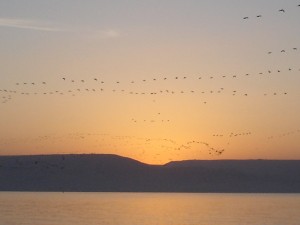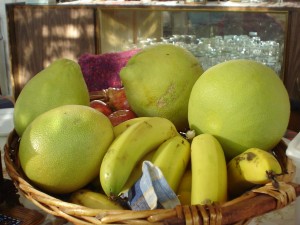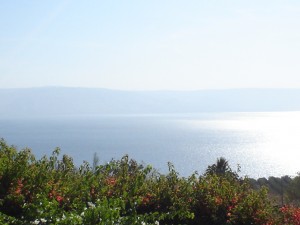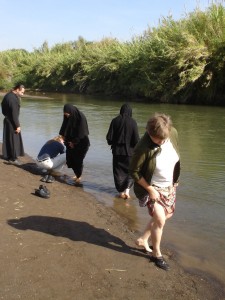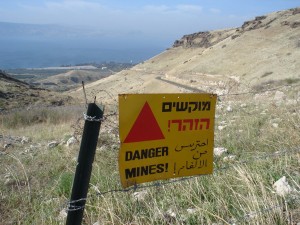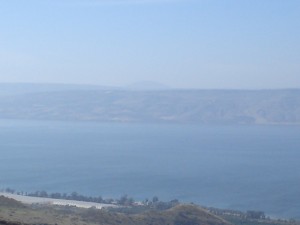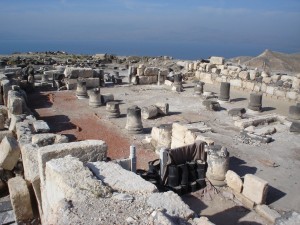(The Accidental Pilgrim, Part 1)
Capernaum, Mount of Beatitudes, Jordan River, Hippo/Susita
Hello from Jerusalem,
The night’s “rest” at the monastery re-emphasized for me just how rural Galilee is. Roosters crowing even before the crack of dawn (not polite, pious roosters giving a single, helpful wake-up call like in the movies, but repeatedly every 20 minutes or so, not conducive to getting back to sleep, or to being very thankful to the Creator for this bit of animal diversity!), a donkey’s raucous hee-hawing and other assorted animal noises. Still, I don’t think any of us woke up too angry at all the noise. That would have been hard to do at sunrise on the Sea of Galilee. The entire body of water is surrounded by hills over which the sun rises and sets. Standing lakeside watching the sky change colors and anticipating the sun’s arrival was a beautiful moment, made more memorable by vast flocks of birds silently flying over the face of the water, looking for fish and moving to their day-time roosts. Seeing several small boats of fishermen (I’m not kidding), made me certain this was a scene similar to what Jesus would have regularly seen. The moment was holy, exciting, transcendent.
After breakfast, Fr. Irinarchos, an energetic 40ish Greek Orthodox priest, gave us a tour of the grounds, showing us ancient grindstones, and other things that were a part of daily life in Capernaum, as well as the results of his clever husbandry of the monastery grounds including trees trained to form a thick roof over picnic tables and peacocks. Before we left, he offered to take us later to an interesting archeological site on the other side of the lake. After visiting other sites with our own monastic guides, we would return to be led by him.
From Capernaum, we drove up to the Mount of Beatitudes. At first glance we weren’t impressed. It looked like a pilgrim processing place. At the gate, pilgrims paid an entrance fee. A new looking building housed a sleek, modern souvenir shop and a high priced snack bar. The church itself is octagonal, made of gray blocks and fairly unremarkable. OK, I thought. Ho Hum. This is nice. What’s next? Then we stepped out onto the church’s porch. The view was marvelous: the water shimmered in the distance, surrounded by green, rolling hills. We saw few people. Lovely. As before, Mother Katherine pulled out the book and we started reading the passage, not just a few verses as before but all three chapters of the Sermon on the Mount. It was while we read this that the Accidental Pilgrim was born, listening to those familiar words in the setting where they were first spoken:
Blessed are the poor in spirit, for theirs is the kingdom of heaven…
Blessed are the peacemakers for they shall see God…
You are the salt of the world…
If anyone strikes you on the right cheek, turn to him the other, also…
Consider the lilies of the field…they neither toil nor spin, yet even Solomon in all his glory was not arrayed as one of these…
Everyone who hears these words of mind and does them will be like a wise man who built his house on a rock…
We were all moved. Each reader (I didn’t even try to read) seemed just this side of tears. I pictured a man standing on this breezy hill overlooking the Sea of Galilee with a large crowd sitting, rapt, hanging on every word, amazed, delighted, maybe even a little disturbed at the message he preached. My wife, later, called one of her cousins the Accidental Pilgrim: coming to the Holy Land to see the sites and read the verses, but once here being surprised by the nearness and reality of the message, of the faith, of God Himself.
From there we saw several other places connected to an event in the life of Jesus, such as where he fed 5,000 people with only five loaves and two fishes, then picked up Fr. Irinarchos, who took us first to the banks of the Jordan river which was a bit chilly, but not really wide. Being local, he took us to the local place: no souvenirs, no entry fee, no bottles of holy water for sale but rather only a smallish river about 20 feet across flowing with as much holy water as you’d care to see at one moment. I was glad the spot was completely natural and perhaps resembled what Jesus knew and saw. We waded in it, splashed some on our faces and hands, and thanked God for cleaning us up.
After the Jordan we proceeded to the ruins of one of the cities of the Decapolis, Hippos (not where Augustine was from), now called Sussita. To get there we had to turn off the main road onto a small lane with a sign that said, “Do not enter,” though the site we were going to is a national park! We drove on a winding road, up and up a hill at least twice as high as the Mt. of Beatitudes to a large outcropping of rock on which the city had once stood. To get to the site, you had to walk a rugged trail with signs on each side that read, “Danger, Land Mines,” not something you see in every national park! This area is on the edge of the Golan Heights which Israel occupied in 1967 and annexed in 1981. You can still see the remnants of the fighting, including barbed wire covered bomb shelters.
From the top, the entire Sea of Galilee was visible: a stunning sight. You could even see Mt. Tabor in the distance.
The city was founded around 240 BC, and destroyed by an earthquake in 700 AD. The ruins of five churches and a monastery made this place amazing and wonderful. Many parts of the site had been cleared but left untended. We had free access to beautiful mosaic floors (protected by archaeologists under a thin layer of sand and cloth), and other pieces of church architecture. We saw a beautifully preserved portion of an iconostasis, the icon screen used in Orthodox churches even to this day. We saw a reliquary which, when first unearthed, had contained the bones of someone, possibly an early Christian martyr, who had clearly died of animal wounds. (The bones had been removed.) In another part of the ruins we saw a slanted floor on which grapes were pressed so the juice could run out through an opening into a large vat where it fermented and became wine, plus olive presses. I took my children to see this place when they were here for Christmas and it was their favorite site in Galilee. It feels very raw and real and almost alive, like the last inhabitants haven’t really been gone all that long, like the last note of the last chant still hangs in the air of that cool, breezy, hilltop.
Galilee connected me, my family, and our guests to Jesus and the early days of the Christian faith in a powerful, surprising way. Before the trip, I didn’t take pilgrims very seriously. Now, I’ve discovered that I am one.

